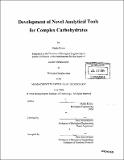| dc.contributor.advisor | Ram Sasisekharan. | en_US |
| dc.contributor.author | Keiser, Nishla, 1978- | en_US |
| dc.contributor.other | Massachusetts Institute of Technology. Biological Engineering Division. | en_US |
| dc.date.accessioned | 2005-09-27T16:48:37Z | |
| dc.date.available | 2005-09-27T16:48:37Z | |
| dc.date.copyright | 2004 | en_US |
| dc.date.issued | 2004 | en_US |
| dc.identifier.uri | http://hdl.handle.net/1721.1/28525 | |
| dc.description | Thesis (Ph. D.)--Massachusetts Institute of Technology, Biological Engineering Division, 2004. | en_US |
| dc.description | Includes bibliographical references. | en_US |
| dc.description.abstract | Complex carbohydrates such as the heparin/heparan sulfate glycosaminoglycans (HSGAGs) and the asparagine linked glycans (N-glycans) have emerged as crucial components of many human biological systems. Both classes of molecules have diverse roles in normal and pathological processes including development, cell growth, wound healing, angiogenesis, viral entry, and cancer. Taking advantage of the ability of carbohydrates to affect biological outcomes, several companies have already begun developing sugar-based structures as therapeutics for malaria and breast cancer, among others. However, the structural complexity that allows HSGAGs and N-glycans to exhibit such a wide array of activities also makes them more difficult to study than their protein and nucleotide counterparts. There are currently no effective methods for rapid synthesis of specific HSGAG or N-glycan structures, and until recently, most common analytical techniques were not useful in this field due to sensitivity constraints. Now, with advances in separation techniques and mass spectrometry, the fundamental roles of biological carbohydrates can be elucidated more efficiently. However, there is still a need for improved methodologies for studying these classes of molecules. This thesis describes the development of a novel technique for the direct isolation and sequencing of protein-binding HSGAG oligosaccharides. As a proof-of-concept, we used heparin and HSGAG-binding proteins of known specificity (fibroblast growth factor and antithrombin III), then utilized the technique to identify an oligosaccharide binder for a protein with unknown HSGAG binding specificity (endostatin). Furthermore, this technique can be readily applied to carbohydrate material from the cell surface. We have | en_US |
| dc.description.abstract | (cont.) optimized methods for harvesting and purifying cell surface HSGAGs that are suitable for use in many experimental procedures. Taken together, these methods will allow for the rapid identification of HSGAG sequences from biologically relevant sources that bind to proteins of interest, potentially leading to new pharmaceutical targets. Not only do carbohydrates represent a huge potential drug market, they have an enormous role in the development of protein therapeutics. Since N-glycans can significantly alter the activity and half-life of proteins, it is essential to have the appropriate glycosylation for maximum effect. We therefore optimized a method for analyzing the carbohydrate component of N-glycans from mass-produced proteins, and compared the glycosylation patterns of the same protein produced in different types of bioreactors. Further, we built upon the methods for analyzing N-glycans from single proteins to obtain a complete N-glycan profile from total serum glycoproteins. Searching for patterns in these profiles may yield new information on N-glycan changes in disease states, and lead to more sensitive diagnostic testing. | en_US |
| dc.description.statementofresponsibility | by Nishla Keiser. | en_US |
| dc.format.extent | 150 p. | en_US |
| dc.format.extent | 7465256 bytes | |
| dc.format.extent | 7484676 bytes | |
| dc.format.mimetype | application/pdf | |
| dc.format.mimetype | application/pdf | |
| dc.language.iso | en_US | |
| dc.publisher | Massachusetts Institute of Technology | en_US |
| dc.rights | MIT theses are protected by copyright. They may be viewed, downloaded, or printed from this source but further reproduction or distribution in any format is prohibited without written permission. | en_US |
| dc.rights.uri | http://dspace.mit.edu/handle/1721.1/7582 | |
| dc.subject | Biological Engineering Division. | en_US |
| dc.title | Development of novel analytical tools for complex carbohydrates | en_US |
| dc.type | Thesis | en_US |
| dc.description.degree | Ph.D. | en_US |
| dc.contributor.department | Massachusetts Institute of Technology. Department of Biological Engineering | |
| dc.identifier.oclc | 57350895 | en_US |
